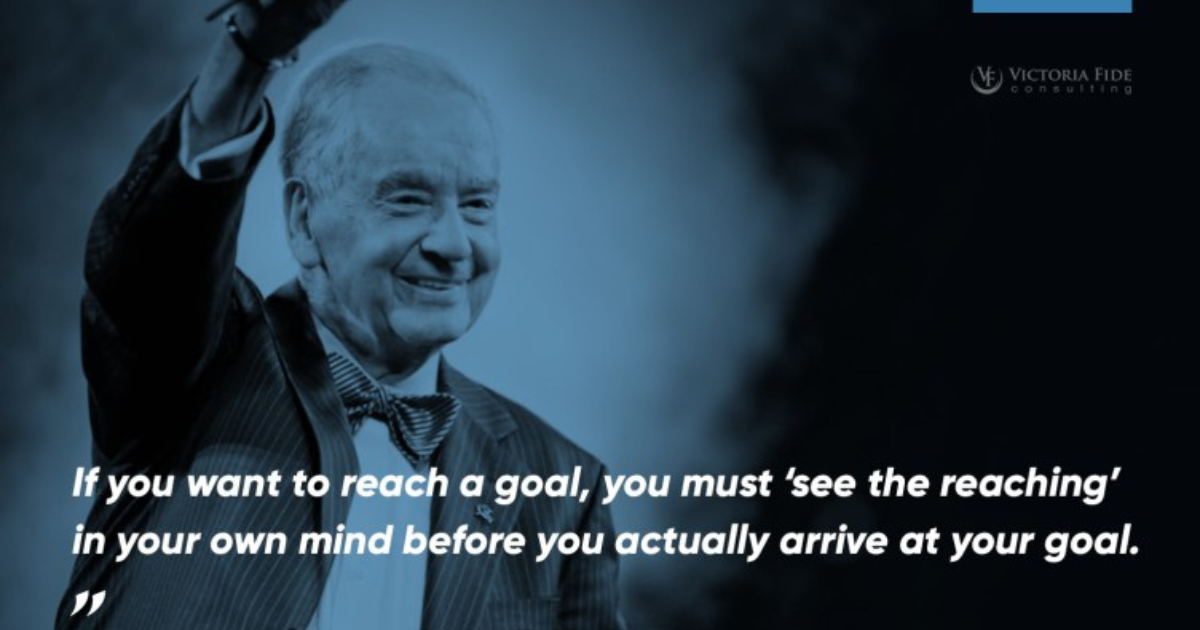
The Sage Wisdom series is produced by Victoria Fide Marketing with input and oversight from our leadership team and industry SMEs.
Zig Ziglar, born Hilary Hinton Ziglar, was a famous American salesman and motivational speaker. Despite experiencing several major life tragedies, Ziglar possessed a unique ability to see things in a positive light. He began his journey to becoming a motivational guru by selling cookware door-to-door. He then authored the bestseller, “See You At The Top,” a classic motivational and self-improvement book that has sold more than 1.6 million copies in hardcover.

One of Zig’s well-known quotes is, “If you want to reach a goal, you must ‘see the reaching’ in your own mind before you actually arrive at your goal.” During a digital transformation (DX), it can be easy to lose sight of the big picture. Businesses often define quality based on metrics that don’t necessarily reflect the success or effectiveness of the project in achieving its intended purpose.
Quality in digital transformation means ensuring that the project delivers the desired business outcomes within a defined standard or level of excellence. It encompasses factors such as the effectiveness of the transformation, the reliability and functionality of the new digital systems, the alignment with business objectives, user satisfaction, and overall outcomes achieved. To reach a high quality in your digital transformation, you must first define your target outcomes and ‘see the reaching’ of your DX goals from the high-level objectives to the most detailed aspects. This article gives you tips on defining your outcomes and achieving continuous improvement.
Cultivating a Visionary Mindset
When embarking on a digital transformation journey, it’s crucial to envision the desired outcomes beforehand. By ‘seeing the reaching’ in your mind, you gain a clear understanding of where you want to go and how to get there. This visualization process helps you in planning and executing an effective DX strategy.
Think of it like mapping out a road trip. You need to first know your destination before choosing the best route to take. In digital transformation, the destination is your business’s desired outcomes, such as improved efficiency, enhanced customer experience, or increased revenue.
Visualizing these outcomes allows you to set specific objectives and milestones. It helps you align your resources, investments, and efforts towards achieving those goals. Additionally, having a clear vision of success allows you to communicate the transformation vision to your team effectively.

Free PDF Download
In the rapidly changing digital landscape, more and more companies are desperately trying to keep up with the competition. Download “The 10 Biggest Mistakes Businesses Make in Digital Transformation” for free today to learn how to use DX to radically transform your business and gain an edge over your competitors.
To drive the entire digital transformation process, cultivating a visionary mindset among business leaders is of utmost importance. When leaders ‘see the reaching’ of the desired business outcomes, it inspires the entire organization.
Moreover, a visionary leader anticipates challenges and opportunities, making proactive decisions to steer the transformation in the right direction. By consistently reinforcing the vision, leaders keep everyone focused on the end goal, ensuring the transformation stays on track even in the face of obstacles.
Defining Target Outcomes
When it comes to DX, the key is to prioritize metrics that directly contribute to achieving your specific business goals. These metrics act as guideposts, helping you make data-driven decisions and accurately measure the success and ROI of your transformation efforts. To determine which metrics to prioritize, it is crucial to first define your target outcomes both at a high-level all the way to low-level details.
For example, if your DX involves an e-commerce platform, you probably have revenue goals for this new sales channel. But when you start thinking about what affects revenue, you realize that one of those things is the speed at which somebody can check out. If it’s difficult to check out, a buyer may decide, “I’m just going to go shop somewhere else.” Your revenue goal is a high-level outcome, and the checkout speed is a low-level outcome. You need to define both as quality measurements.
Setting High-Level Objectives – Aim Big and Strategize
High-level objectives serve as a compass, pointing your team toward the ultimate business outcomes. They provide clarity and purpose, ensuring that every effort is aligned with the broader vision. As you set these objectives, keep in mind how they directly tie to your business’s success.
Imagine you’re leading a retail company’s digital transformation involving an e-commerce platform. One of your high-level objectives might be to hit a certain revenue goal for this new sales channel. This objective sets the direction for your transformation. By reverse engineering this goal, you can pinpoint relevant Key Performance Indicators (KPIs) that are directly aligned with your overarching goal, ensuring you are accurately and efficiently moving in the right direction.
Detailing Low-Level Aspects – Plan with Precision
Breaking down your high-level objectives into actionable and measurable aspects is vital for successful transformation.
Granular planning comes into play as you strategize how to achieve this aspect. You might identify tasks like streamlining the checkout flow, offering multiple payment options, and implementing a user-friendly interface. Each of these low-level tasks contribute to the high-level goal of increased revenue.
By detailing low-level aspects, you ensure that no essential steps are overlooked. Moreover, it provides a roadmap for your team, enabling them to track progress and measure success at each stage of the transformation.
Always remember to keep your eyes on the metrics that matter most for your business objectives. By doing so, you’ll ensure more effective project management and better decision-making, leading to a more impactful and successful DX journey.
‘See the Reaching’: Key Lessons for Success in Digital Transformation
Zig Ziglar’s wise quote, “If you want to reach a goal, you must ‘see the reaching’ in your own mind before you actually arrive at your goal,” holds valuable lessons for businesses embarking on digital transformation.
As you undertake the exciting journey of digital transformation, remember to visualize your desired outcomes, and set high-level and low-level objectives that align with your business goals. Having a clear vision guides your efforts and empowers your team to work toward a common purpose.
Furthermore, defining quality in digital transformation should be based on measurable business outcomes. Always prioritize metrics that directly relate to achieving specific business goals. These business-driven metrics enable data-driven decision-making and help you measure the success of your transformation efforts accurately.
By adhering to these principles and focusing on measurable business outcomes, you can achieve successful results in your digital transformation. Your journey to embracing new technologies and enhancing your business processes will position you for continued growth and competitiveness in the dynamic digital economy. With Zig Ziglar’s timeless wisdom in mind, forge ahead on your digital transformation path, confident in your ability to ‘see the reaching’ of your goals and achieve the quality-driven success your business deserves.
Subscribe to our weekly LinkedIn Digital Transformation Success newsletter and get notified of each new edition.
